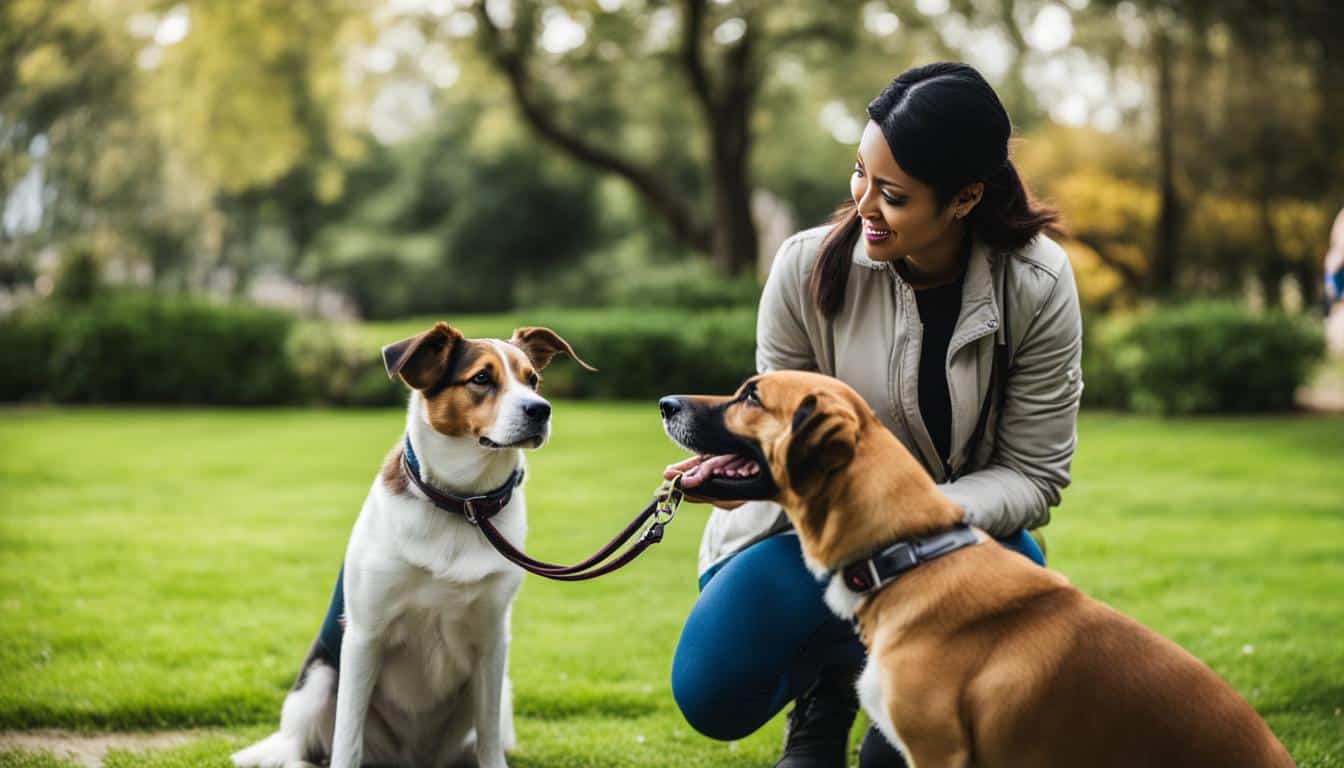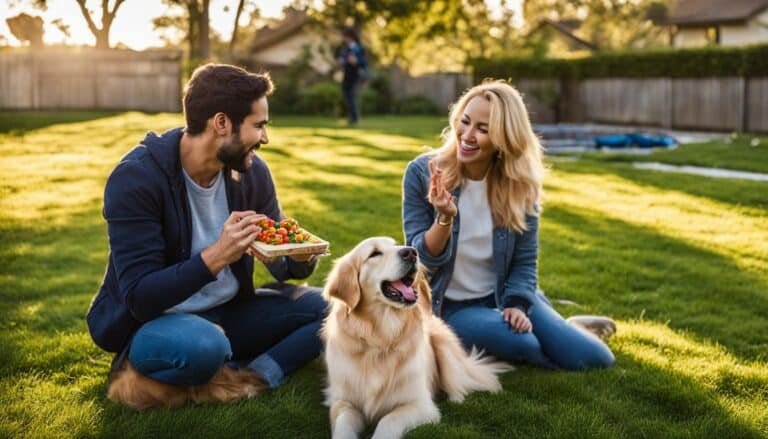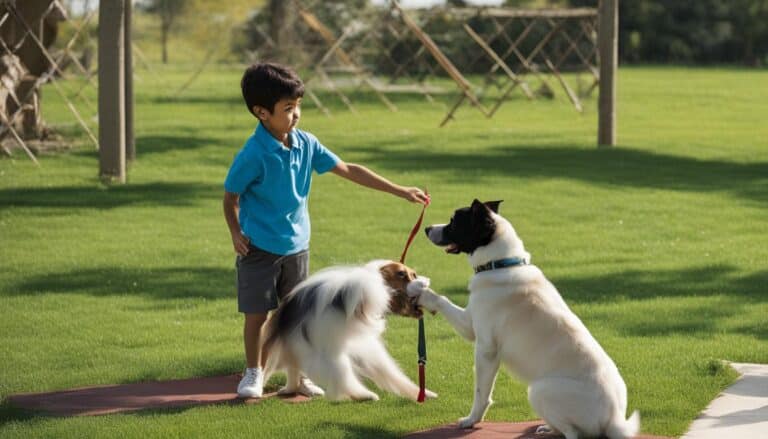How to Train Your Dog on a Lead
Are you tired of being pulled around on walks by your over-enthusiastic furry friend? Do you dream of enjoyable strolls where your dog walks calmly by your side? Well, you’re in the right place! In this article, we’ll show you the ropes of leash training, so you can finally experience stress-free walks with your dog.
Meet Max, a spirited Labrador Retriever who loved nothing more than to dash off in pursuit of squirrels during his walks. His owner, Sarah, had tried almost everything to keep Max under control, from using multiple leashes to resorting to arduous training sessions. But nothing seemed to work.
Frustrated, Sarah decided it was time to take a different approach. She started researching dog training lead techniques and stumbled upon the secret to successful leash training: teaching her dog that not pulling was the fastest way to get to where he wanted to go.
Excited by this newfound knowledge, Sarah began implementing a step-by-step training plan. She discovered the power of positive reinforcement, using treats and praise to encourage Max to stay close by her side. Sarah also learned the importance of making their surroundings fun and rewarding for Max, creating an enticing environment that kept his attention focused on her.
Over time, Sarah observed gradual improvements in Max’s behavior. He started paying more attention to her cues and staying within range. Sarah even discovered that using aversive techniques or punishment only hindered Max’s progress. Instead, she embraced patience, consistency, and reward-based training to keep Max motivated and engaged.
Now imagine experiencing the same transformation with your dog. Walking side by side, enjoying the fresh air, and experiencing a strong bond between you and your furry companion. In the following sections, we will guide you through the process of leash training, providing valuable tips, techniques, and troubleshooting advice to ensure you master the art of walking your dog on a leash. So, let’s dive in and start your journey to stress-free walks together!
Importance of Walking Your Dog on a Leash
Daily walks are essential for your dog’s health and wellbeing. Walking not only helps keep dogs fit and maintain a healthy weight, but it also fulfills their behavioral needs. It provides an opportunity for socialization and allows them to explore their environment. But to ensure a positive walking experience, it’s important to train your dog to walk on a leash.
Using the right equipment is key to successful leash training. Invest in a sturdy leash that provides you with control while still giving your dog freedom to move comfortably. Choose a well-fitted collar or harness that doesn’t cause any discomfort or restrict your dog’s movement.
Reward-based training is widely recognized as the most effective and humane approach to leash training. Start with the “loose-leash walking” technique, where you reward your dog for walking without pulling. This method encourages your dog to maintain a relaxed and obedient state while on the leash.
Avoid using equipment that causes pain or discomfort, such as choke chains or prong collars. These can harm your dog physically and have adverse effects on their behavior. Opt for positive reinforcement methods that strengthen the bond between you and your dog.
Remember, building a strong foundation for leash training takes time and consistency. Practice regularly and remain patient with your dog as they learn. With the right training techniques and equipment, you can enjoy safe and enjoyable walks with your four-legged companion.
Step-by-Step Leash Training Process
When it comes to leash training your puppy, a step-by-step approach can help them master proper leash control and become an obedient walking companion. Follow these effective leash training methods to ensure success:
- Introduce your puppy to the collar or harness and leash gradually. Make it a positive experience by associating it with rewards and treats.
- Teach a cue sound, such as a clicker or a specific word like “food is coming,” to signal that a reward is on its way. Use this cue to reinforce desirable behaviors during the training process.
- Begin by practicing in a distraction-free area. Take a few steps and encourage your puppy to come to you. Reward them for coming to your side and staying close.
- Gradually increase the challenges as your puppy becomes more comfortable. Practice walking inside, around the house, and eventually venture outside to more stimulating environments.
- Be patient and keep the initial walks short. Gradually increase the duration of the walks as your puppy becomes more confident and in control.
- Use positive reinforcement and rewards, such as treats and praise, to encourage your puppy’s good leash-walking behavior. Reinforce the concept that staying close without pulling is rewarding.
- If your puppy exhibits common issues like pulling or lunging, address them with gentle techniques. Maintain distance and redirect their attention to you using the cue sound or treats.
Remember to be consistent, patient, and reward your puppy for their progress along the way. With time and practice, you’ll master dog lead training and enjoy pleasant walks with your well-trained companion. Check out the image below for a visual guide to mastering leash control for dogs:
Using Rewards and Positive Reinforcement
Reward-based training is a crucial aspect of effective leash training for dogs. By using rewards such as tasty treats, praise, or toys, you can encourage positive behaviors in your dog. When your dog walks on a leash without pulling, be sure to reward them every few paces with a treat to reinforce good leash-walking behavior.
It’s important to make training sessions enjoyable for both you and your dog. By incorporating rewards and positive reinforcement, you can create a positive association with leash training. This will motivate your dog to engage in the desired behavior and make the training process more enjoyable.
If your dog starts to pull on the leash, it’s essential to address this behavior. Rather than pulling back or resorting to punishment, simply stand still temporarily. This teaches your dog that pulling will not get them where they want to go. Once they return to your side, reward them for coming back and continue walking.
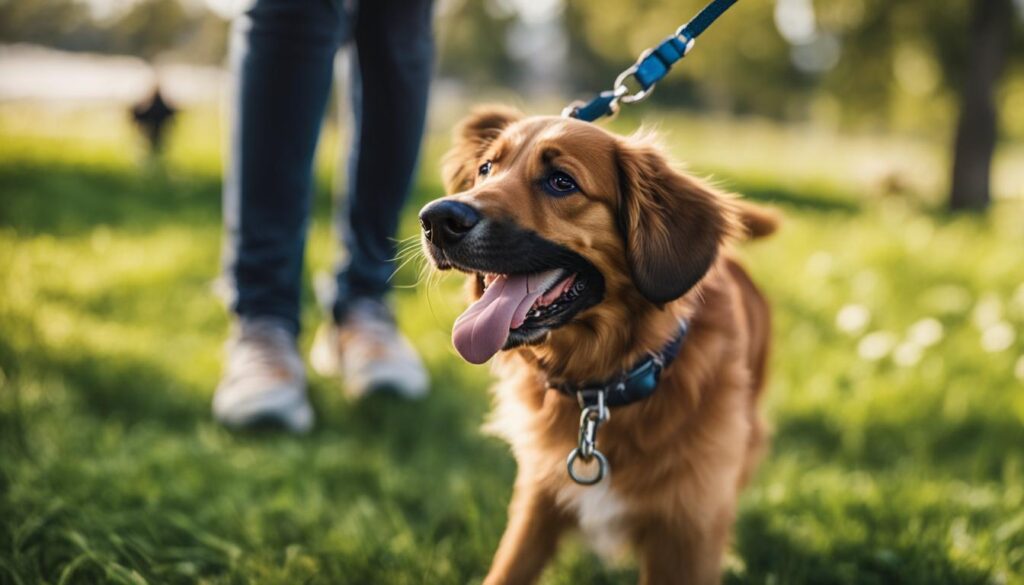
In some cases, despite consistent training, dogs may continue to pull on the leash. In these situations, using a front-attach harness can be helpful. The harness redirects your dog’s natural pulling instinct to the side, making it more difficult for them to exert force forward. This can aid in teaching them proper leash-walking behavior.
In addition to teaching your dog to walk nicely on a leash, it’s important to train them to leave items alone when instructed to do so. By using cues such as “leave it” or “drop it,” you can teach your dog to move away from objects and focus on you. Reward them for responding to these cues and reinforce the desired behavior.
Troubleshooting Leash Training Issues
Leash training for dogs can sometimes present challenges, especially as your dog gets older and encounters new distractions. However, with the right techniques and consistent training, you can address these issues and ensure a successful leash training experience.
- If your dog pulls on the leash, it’s important to stop and refuse to move forward until they come back to you. This teaches them that pulling is not an effective way to move forward.
- Avoid yanking or jerking the leash as it can cause discomfort or harm to your dog. Instead, use gentle pressure and release techniques to guide them in the desired direction.
- Consider using training tools such as front-hook harnesses or head halters for dogs that tend to pull excessively. These tools provide additional control and can help redirect your dog’s focus during walks.
- If your dog tends to lunge at other dogs or distractions, redirect their attention by offering a treat or creating distance between them and the target. This allows your dog to calm down and regain focus.
- If your dog barks or reacts anxiously towards other dogs, ensure they are receiving enough mental and physical stimulation in their daily routine. Additionally, create distance between your dog and other dogs during walks to redirect their attention and minimize trigger responses.
- As your dog becomes more skilled at leash walking, gradually reduce the use of treats as rewards. This encourages your dog to walk nicely on a leash without solely relying on treats for good behavior.
To address and overcome leash training challenges, patience, consistency, and positive reinforcement are key. By using these troubleshooting techniques and providing guidance to your dog, you can ensure successful leash control and enjoyable walks together.
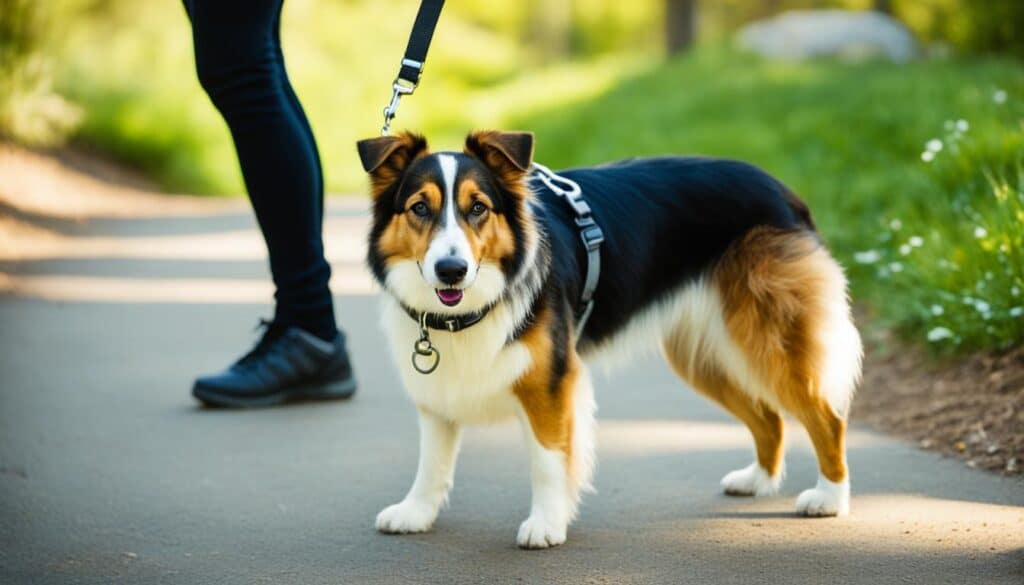
Making Walks Enjoyable
When it comes to walking your dog on a leash, it’s crucial to make the experience enjoyable for both you and your furry friend. By using positive reinforcement and rewards throughout the training process, you can create a positive association with walking on a lead.
To start, make the area around you fun and rewarding for your dog. This can be achieved by incorporating treats and toys into your walks. By doing so, you’re creating an environment that encourages your dog to stay close to you and prevents them from rushing to their destination.
Encouragement plays a vital role in teaching a dog to walk nicely on a lead. Offer lots of praise when your dog exhibits the desired behavior of walking calmly beside you. Additionally, reward them with treats to reinforce this behavior and motivate them to continue walking politely.
Remember to keep the training experience positive and enjoyable throughout. By making walks a fun and rewarding activity, your dog will be more inclined to walk nicely on a lead and enjoy the time spent with you.
Seeking Professional Help
If you’re struggling with dog training lead techniques or facing challenges with leash control for dogs, don’t hesitate to seek the assistance of a professional. Sometimes, the expertise of a dog trainer or animal behaviorist can make a world of difference in improving your dog’s behavior and making walking your dog on a leash a more enjoyable experience.
Start by consulting your veterinarian, who can provide recommendations for accredited dog trainers or behaviorists in your area. These professionals have the knowledge and experience to guide you through the leash training process and address any specific issues you may be facing.
Professional help can be especially valuable if your dog’s behavior is influenced by underlying medical conditions. A trained expert can identify and address any medical issues that may be affecting your dog’s behavior, helping you develop effective strategies for leash control and walking your dog on a leash.
Remember, seeking professional help is not a sign of failure but rather a proactive step toward ensuring the best possible outcome for you and your furry friend. With expert guidance, you can overcome any obstacles and master the art of leash training, fostering a stronger bond and a happier, well-behaved dog.
Enjoying Safe and Happy Walks
Training your dog to walk nicely on a lead is a journey that requires time, patience, and consistency. By following the steps outlined in this article and using positive reinforcement, you can master dog lead training and enjoy enjoyable, obedient walks with your furry companion.
Walking your dog on a leash not only ensures their safety but also allows for happy outings for both you and your four-legged friend. With leash control for dogs, you can confidently explore your neighborhood or parks, knowing that your dog will stay by your side.
Remember to enjoy the process of teaching your dog leash manners. Celebrate every milestone and reinforce good behaviors such as walking without pulling. With time and practice, you and your dog will establish a strong bond and have many memorable adventures together. So grab your leash, put on a smile, and embark on safe and happy walks with your well-trained dog!
